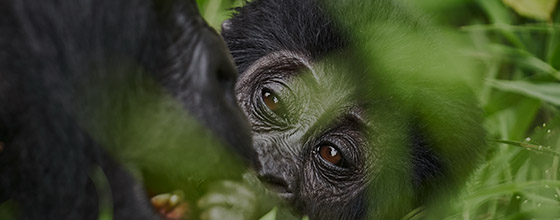
Bwindi Impenetrable National Park | Gorilla Tracking in Uganda
Bwindi Impenetrable National Park (BINP) covers an area of 321 km² between 1,160m and 2,607m above sea level. Bwindi was gazetted as a National Park in 1991 and declared a UNESCO Natural World Heritage site in 1994. The Mubare gorilla group at Buhoma was the first to be habituated for tourism in Bwindi in April 1993. A total of fifteen groups have now been habituated for tourism and are tracked from four trailheads. Uganda’s foremost tourist attraction, and indeed one of the world’s most remarkable wildlife encounters, is tracking mountain gorillas through the remote Bwindi Impenetrable forest of south-western Uganda.
These magnificent apes are both rare and endangered; their total population numbers less than 800 animals divided between the forests of Bwindi Impenetrable and the nearby Virunga volcanoes. With fifteen groups habituated for tourism, the Impenetrable Forest is the world’s primary mountain gorilla tracking destination. There is however much more to Bwindi than gorilla tracking. Forest trails lead to scenic waterfalls and rift valley viewpoints while community walks through local villages provide insights into the lives of the Batwa (Pygmy) and Bakiga people living beside the forest. Bwindi is also one of Uganda’s top birdwatching destinations with many Albertine Rift endemics present, notably in the high, draughty Ruhija sector.
Access to Bwindi Impenetrable National Park
Roads
The main trailhead at Buhoma is about 460kms from Kampala and can be reached by road from several directions. The main safari circuit approaches from the north through the Ishasha sector of Queen Elizabeth National Park (QENP), providing a chance to search for the famous tree-climbing lions. BINP is 160kms from Mweya in central QENP and 62 kms from Ishasha. The most direct route from Kampala follows a surfaced road to Rukungiri via Mbarara and Ntungamo. A slow dirt road then winds through the highlands to Buhoma via Kihihi and Butogota. Ruhija trailhead is best accessed from the Kampala-Kisoro road, turning north from the surfaced highway 18km beyond Kabale town. The southerly Rushaga and Nkuringo trailheads can be reached using dirt roads leading west from Muko, midway on the surfaced Kabale -Kisoro road, and north from Kisoro town. Note: a 4×4 vehicle is recommended for a Bwindi visit.
Air
Travelers can fly from Entebbe International Airport or Kampala’s Kajjansi airfield to Kisoro (for Nkuringo, Rushaga and Ruhija) and to Savanna and Ishasha airstrips (for Buhoma). Prior transport arrangements for transfer to the park are required.
CLIMATE
The forest can be cold, especially in the morning and at night; the annual average temperature range is 7oC – 20oC with the coldest period being June and July. As well as warm clothing, wet weather gear is essential since Bwindi receives up to 2,390 mm of rain per year.
WHEN TO VISIT
The park can be visited any time of the year.
ACCOMMODATION
Accommodation facilities at the four trailheads cater for up-market, mid-range and budget visitors. Ruhija trailhead can also be reached from hotels in Kabale and Lake Bunyonyi, while visitors to Rushaga and Nkuringo have the option of staying in Kisoro or Lake Mutanda.
Local People
The Bwindi area is the home of the Bakiga, a farming people who are responsible for the striking terraced hillsides that extend up to the edge of the forest to the south of Bwindi. Traditionally the interior of Bwindi was home to Batwa (Pygmy) hunter-gatherers who now live on the edge of the forest.
Mountain Gorilla Tracking
The highlight of a visit to Bwindi – and the climax of the long journey to the Impenetrable Forest by air, car and steep, forest trail – is a magical hour in the company of a family of mountain gorillas. Tracking the gorillas can last from a few hours to a whole day, depending on how far the group has moved since it was observed nesting up the previous evening. Bwindi has fifteen habituated gorilla groups that are tracked from four trailheads. Three of these groups are found in the vicinity of Buhoma in northwest Bwindi; four at Ruhija in the east; and eight at the park’s southern trailheads at Nkuringo and Rushaga. Eight permits are available to track each of the fifteen habituated groups, giving a daily maximum of 120 permits. Permits must be booked in advance through the UWA Booking Office in Kampala. Registration commences at 07.30 hours followed by a briefing at 08.00 hours. Tracking starts at 08.30.
Gorilla rules
To protect the gorillas and visitors, a number of rules and guidelines have been set and must be adhered to. Ensure you get a copy of these rules from the reservations office or at the park. Note that visitors participating in gorilla tracking must be aged 15 or over.
Birding
Bwindi’s four trailheads all offer excellent birding opportunities with the prospect of checking off forest rarities. The River Ivi Trail between Buhoma and Nkuringo is recommended, as is Buhoma’s forest-edge Munyaga River Trail. Ruhija’s Bamboo Trail, leading to the 2607m Rwamunyoni peak, and Mubwindi Swamp Trail are renowned for Albertine Rift endemics including the localized green broadbill.
Nature walks
Though gorilla tracking is the main attraction, other walks provide more relaxed opportunities to explore one of Uganda’s loveliest rainforests. The following walks can be arranged to depart in the morning at 09.00 and in the afternoon at 14.00.
Munyanga River Trail, in the valley below the Buhoma trailhead, provides a short walk to view birds and primates along the forest edge. Waterfall Trail leads through one of Uganda’s most pristine tracts of rainforest, passing beneath tree ferns, epiphytic ferns and orchids to visit three sparking crystal clear waterfalls. Rushura Hill Trail provides expansive views across the plains of the Albertine Rift Valley and (on clear days) to Lake Edward and the Rwenzori Mountains to the north.
Muzabajiro Loop Trail climbs to the summit of Rukubira Hill for breathtaking views of Bwindi forest, the Albertine Rift Valley and the Virunga volcanoes. River Ivi Trail follows an old road through beautiful forest emerging near Nkuringo on the southern edge of the forest.
Community Walks
Community walks through forest edge villages at Buhoma and Nkuringo provide insights into the lives of the local Batwa (Pygmy) and Bakiga peoples. The Buniga Forest Walk at Nkuringo is conducted by Batwa guides who demonstrate their traditional forest lore.
